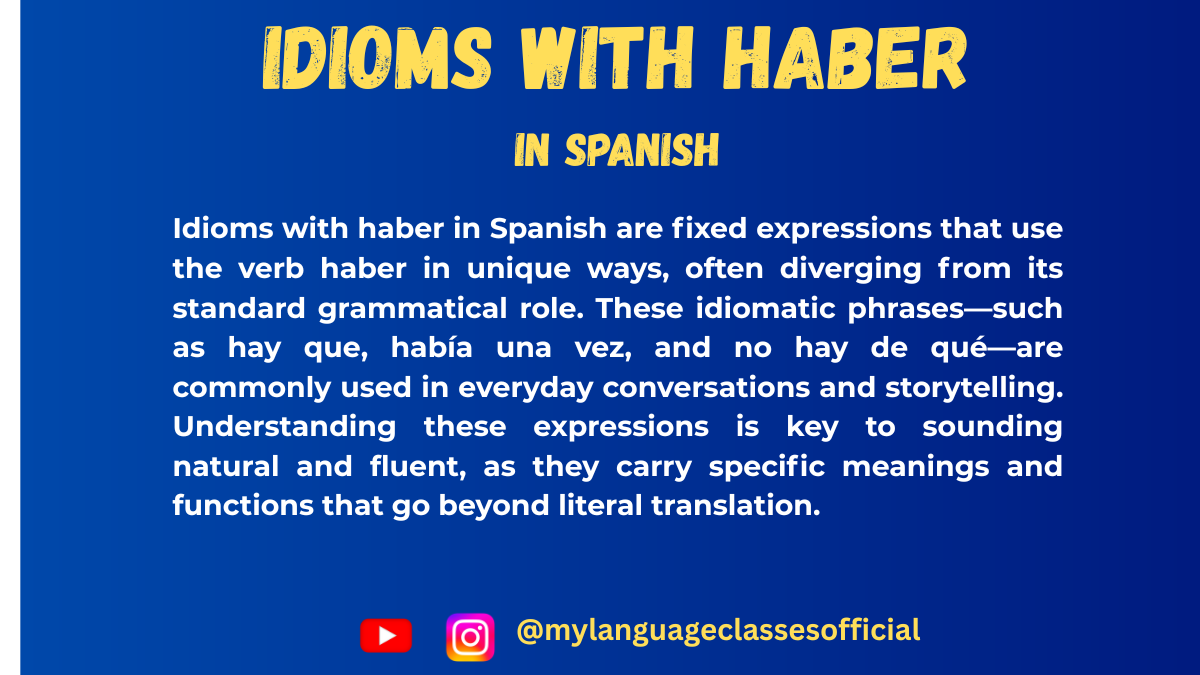Your cart is currently empty!
Tag: common Spanish expressions
-
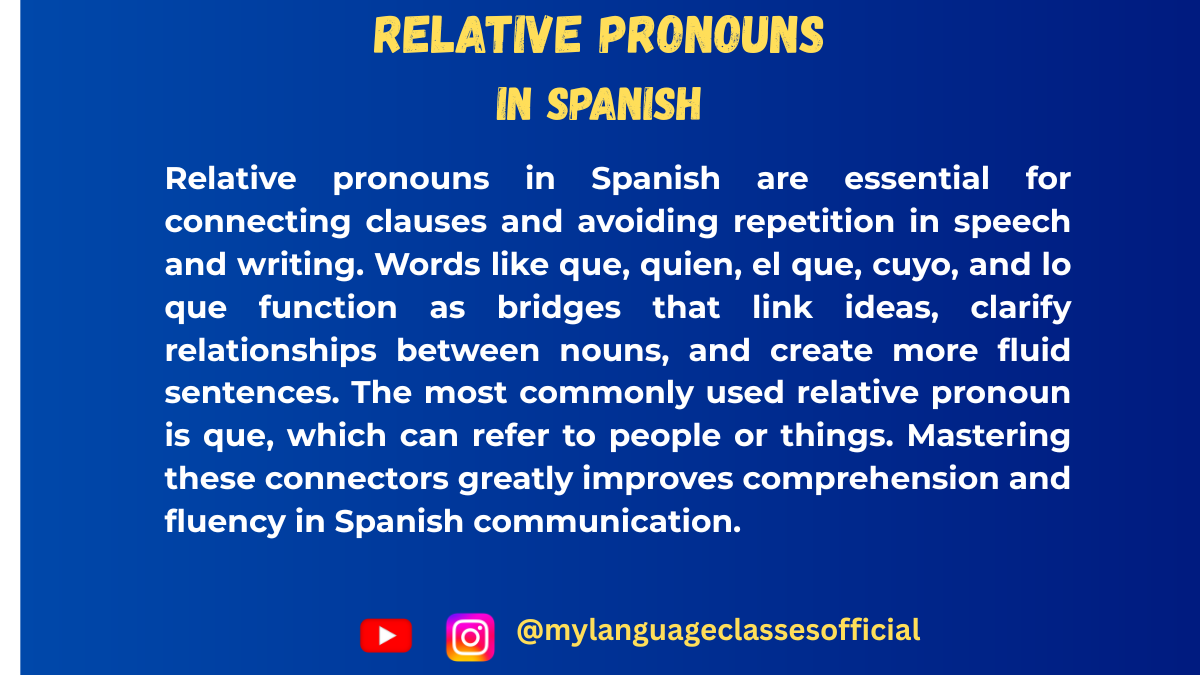
Relative Pronouns in Spanish: Que, Quien, Donde, and Others
When learning Spanish, relative pronouns are essential for connecting sentences smoothly and making speech more fluid. These pronouns allow us to refer to people, places, or things without unnecessary repetition. In this blog post, we will explore the different relative pronouns in Spanish, their meanings, and how to use them correctly.
List of Relative Pronouns in Spanish
Relative pronouns in Spanish are used to introduce subordinate clauses and refer to a previously mentioned noun (antecedent). Below is a list of the most common relative pronouns, their meanings, and example sentences:
Relative Pronoun Meaning Example Sentence 1 Example Sentence 2 Que That, which, who La casa que compré es muy grande. La película que vimos fue interesante. Quien / Quienes Who, whom Mi amiga, quien vive en Madrid, me visitó ayer. Los estudiantes, quienes aprobaron, celebraron. Cuyo / Cuya / Cuyos / Cuyas Whose El hombre cuyo coche es rojo está aquí. La chica cuya madre es doctora es mi amiga. Donde Where La ciudad donde nací es hermosa. Este es el restaurante donde cenamos anoche. El que / La que / Los que / Las que The one(s) who/that El libro, el que compraste, es interesante. Las chicas, las que llegaron tarde, son mis amigas. El cual / La cual / Los cuales / Las cuales The one(s) who/that (formal) La casa en la cual crecí está en ruinas. Los estudiantes, los cuales fueron premiados, estaban felices. Lo que What, which No entiendo lo que dijiste. Lo que más me gusta es viajar. Lo cual Which (referring to a whole idea) Perdimos el tren, lo cual fue un problema. Llegó tarde, lo cual nos molestó mucho. Cuanto / Cuanta / Cuantos / Cuantas As much/many as Toma cuanto quieras. Cuantas veces lo intentó, falló. More Example Sentences
- La mujer que trabaja en la tienda es muy amable.
- Mi amigo, quien es muy inteligente, siempre me ayuda.
- El perro cuyo dueño es mi vecino es muy juguetón.
- No entiendo lo que está pasando.
- El país donde nací es hermoso.
- Los estudiantes, los cuales estudian mucho, sacaron buenas notas.
- La casa en la que crecí tiene muchos recuerdos.
- No sé lo que quieres decir.
- Las flores que compraste son muy bonitas.
- La ciudad donde vivo tiene muchas atracciones turísticas.
Things to Keep in Mind
- Agreement in Gender and Number:
- “Cuyo” agrees in gender and number with the noun it modifies: El hombre cuyos hijos estudian aquí…
- “El que, la que, los que, las que” also change according to the noun they refer to.
- Use of Articles:
- “El cual, la cual, los cuales, las cuales” often appear with a preposition and are more formal.
- “Lo que” and “lo cual” refer to entire ideas or situations.
- Que vs. Quien:
- “Que” is used for both people and objects.
- “Quien” is used mainly for people and must match singular or plural (quien/quienes).
- Where to Use Relative Pronouns:
- “Donde” is for places.
- “Lo que” and “lo cual” refer to abstract concepts.
- “Cuyo” means “whose” and agrees with the possessed noun.
Fill in the Blanks
- La chica _______ vive al lado es muy simpática.
- El perro _______ dueño es mi vecino ladra mucho.
- No entiendo _______ dices.
- La ciudad _______ naciste es hermosa.
- Mi amigo, _______ es doctor, trabaja en el hospital.
- Las flores, _______ compraste ayer, están muy bonitas.
- Juan, _______ hermano es mi compañero, me ayudó con la tarea.
- La razón por _______ llegamos tarde fue el tráfico.
- No sabía _______ querías decir.
- El edificio _______ ventanas son grandes es nuevo.
Answers
- que
- cuyo
- lo que
- donde
- quien
- las que
- cuyo
- la cual
- lo que
- cuyas
Conclusion
Mastering relative pronouns in Spanish is essential for improving fluency and making speech more natural. Understanding the gender, number agreement, and context in which each pronoun is used will help you construct sentences more accurately. Keep practicing with different sentence structures, and soon, using these pronouns will become second nature.
If you enjoyed this lesson, be sure to check out more posts like this on my blog at My Language Classes. Don’t forget to subscribe my YouTube channel and follow me on Instagram for the latest language learning tips and lessons. Leave a comment below to share your thoughts, or ask any questions you have.
Happy learning! 😊
-
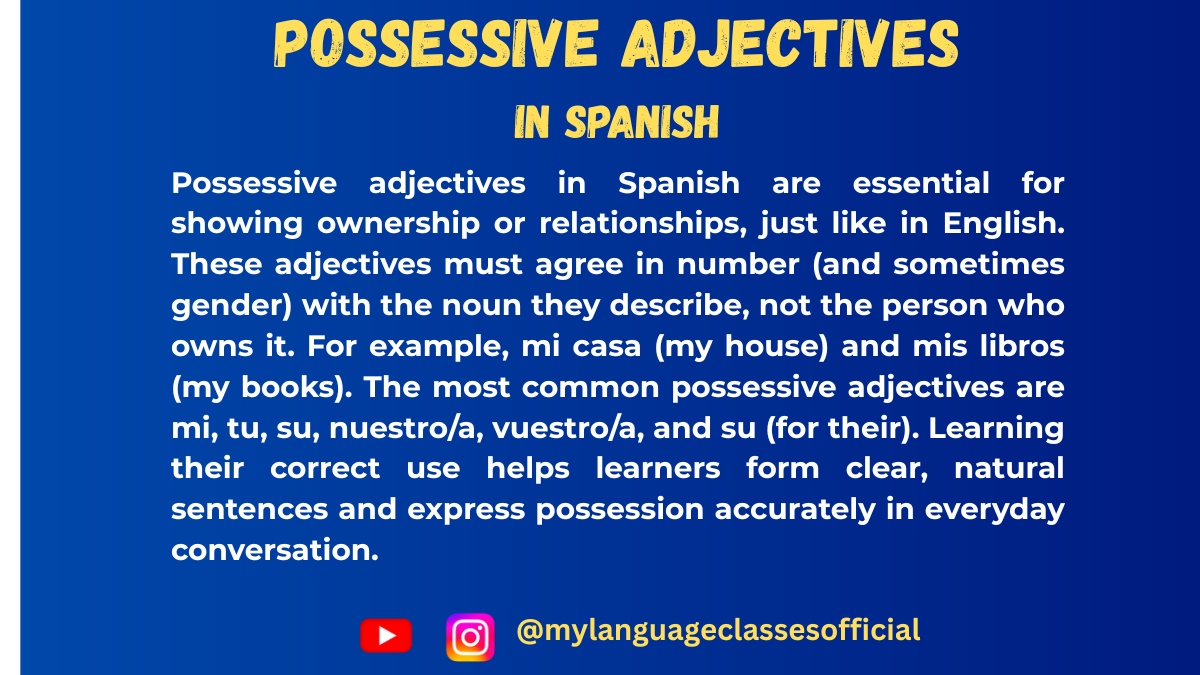
Possessive Adjectives in Spanish
Possessive adjectives in Spanish are essential for indicating ownership or relationships. They agree in gender and number with the noun they modify and are categorized into two forms: short-form possessive adjectives and long-form possessive adjectives.
Short-Form Possessive Adjectives
These adjectives come before the noun and agree only in number (except for “nuestro” and “vuestro,” which also agree in gender).
Singular Possessor Singular Noun Plural Noun mi (my) mi casa (my house) mis casas (my houses) tu (your, informal) tu coche (your car) tus coches (your cars) su (his, her, its, your formal) su perro (his dog) sus perros (his dogs) nuestro/a (our) nuestro amigo (our friend) nuestros amigos (our friends) vuestro/a (your, plural informal) vuestra madre (your mother) vuestras madres (your mothers) su (their, your plural formal) su profesor (their teacher) sus profesores (their teachers) Examples Sentences:
- Mi casa es grande. (My house is big.)
- Tus zapatos son nuevos. (Your shoes are new.)
- Su hermano vive en Madrid. (His brother lives in Madrid.)
- Nuestra escuela es moderna. (Our school is modern.)
- Vuestras mochilas están en la mesa. (Your backpacks are on the table.)
- Sus ideas son interesantes. (Their ideas are interesting.)
Long-Form Possessive Adjectives
These adjectives come after the noun and agree in both gender and number with the noun. They emphasize ownership.
Singular Possessor Singular Masculine Singular Feminine Plural Masculine Plural Feminine mío/a (mine) el libro mío (my book) la casa mía (my house) los libros míos (my books) las casas mías (my houses) tuyo/a (yours, informal) el coche tuyo (your car) la bolsa tuya (your bag) los coches tuyos (your cars) las bolsas tuyas (your bags) suyo/a (his, hers, yours formal) el perro suyo (his dog) la idea suya (her idea) los perros suyos (his dogs) las ideas suyas (her ideas) nuestro/a (ours) el amigo nuestro (our friend) la profesora nuestra (our teacher) los amigos nuestros (our friends) las profesoras nuestras (our teachers) vuestro/a (yours, plural informal) el coche vuestro (your car) la casa vuestra (your house) los coches vuestros (your cars) las casas vuestras (your houses) suyo/a (theirs, yours plural formal) el libro suyo (their book) la comida suya (their food) los libros suyos (their books) las comidas suyas (their foods) Examples Sentences:
- Esa mochila es mía. (That backpack is mine.)
- El coche rojo es tuyo. (The red car is yours.)
- La casa grande es suya. (The big house is his/hers.)
- La responsabilidad es nuestra. (The responsibility is ours.)
- El problema es vuestro. (The problem is yours.)
- Las ideas son suyas. (The ideas are theirs.)
Key Differences Between Short and Long Forms
- Position in the sentence: Short forms come before the noun; long forms come after the noun.
- Emphasis: Long forms emphasize possession and ownership more strongly.
- Agreement: Long forms agree in both gender and number, whereas short forms only change for number (except “nuestro” and “vuestro”).
Common Expressions Using Possessive Adjectives
Here are some useful phrases commonly used in daily life:
Spanish English Mi amor My love Mi casa es tu casa My house is your house (Feel at home) A su servicio At your service En su tiempo libre In his/her free time A mi manera In my way A su gusto To his/her liking Nuestros pensamientos Our thoughts Vuestra responsabilidad Your responsibility Lo mío es importante What is mine is important Un amigo mío A friend of mine Example Sentences Using Expressions:
- Mi casa es tu casa, siéntete cómodo. (My house is your house, make yourself comfortable.)
- A su gusto, puede elegir cualquier opción. (To his/her liking, they can choose any option.)
- En su tiempo libre, le gusta leer. (In his/her free time, he/she likes to read.)
- Nuestros pensamientos son similares. (Our thoughts are similar.)
Things to Keep in Mind When Using Possessive Adjectives
- Article Usage: Short-form possessive adjectives do not need an article, while long-form adjectives can be used with definite articles (el, la, los, las):
- Mi coche es rojo. (My car is red.)
- El coche mío es rojo. (The car of mine is red.)
- Plural and Gender Agreement:
- If the noun is plural, the possessive adjective must be plural.
- If the noun is feminine, adjectives ending in -o change to -a (e.g., “mío” → “mía”).
- Ambiguity of “su/sus”: “Su” and “sus” can mean “his, her, their, your (formal),” leading to confusion. To clarify, use “de + pronoun/name”:
- Su coche es nuevo. (His/her/your/their car is new.)
- El coche de Juan es nuevo. (Juan’s car is new.)
- El coche de ellos es nuevo. (Their car is new.)
Final Thoughts
Possessive adjectives are an integral part of Spanish grammar, making conversations clearer and more precise. Understanding the difference between short and long forms, as well as their proper agreement with nouns, will greatly improve your fluency. Practice using these adjectives in daily conversations, and soon, they’ll become second nature!
Did you find this guide helpful?
Let us know in the comments below or practice by writing a few sentences using possessive adjectives!
If you enjoyed this lesson, be sure to check out more posts like this on my blog at My Language Classes. Don’t forget to subscribe my YouTube channel and follow me on Instagram for the latest language learning tips and lessons. Leave a comment below to share your thoughts, or ask any questions you have.
Happy learning! 😊
-
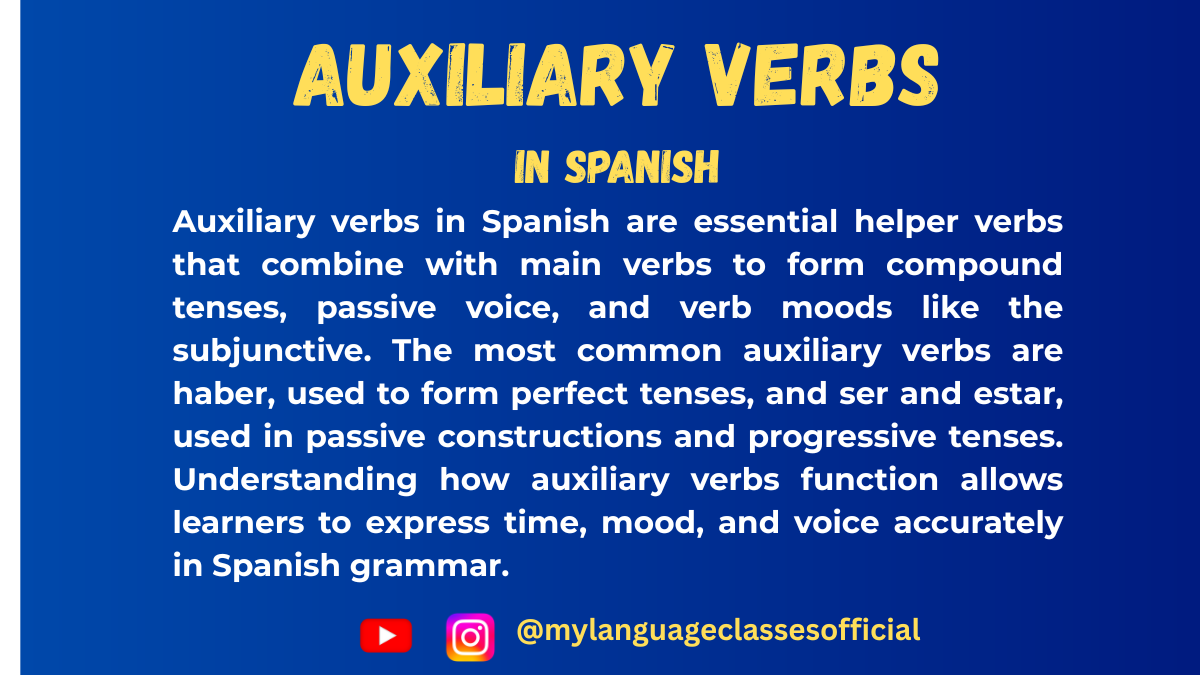
Auxiliary Verbs in Spanish: A Complete Guide
Auxiliary verbs, or “verbos auxiliares” in Spanish, play a crucial role in forming various tenses, moods, and grammatical structures. They are used in conjunction with main verbs to express nuances such as obligation, ability, probability, or temporality. Understanding auxiliary verbs is essential for mastering Spanish fluency.
Common Auxiliary Verbs in Spanish
- Haber (to have – for perfect tenses)
- Ser (to be – for passive voice and descriptions)
- Estar (to be – for progressive tenses and states)
- Tener que (to have to – for obligations)
- Deber (must/should – for necessity and advice)
- Poder (can – for ability and permission)
- Ir a (going to – for future actions)
- Querer (to want – for desires and intentions)
- Soler (to usually – for habitual actions)
1. Haber: Forming Perfect Tenses
Haber is used as an auxiliary verb to form compound tenses like the present perfect, past perfect, and future perfect.
Conjugation of Haber (Present Indicative):
- Yo he
- Tú has
- Él/Ella/Usted ha
- Nosotros/as hemos
- Vosotros/as habéis
- Ellos/Ellas/Ustedes han
Example Sentences:
- Yo he comido hoy. (I have eaten today.)
- ¿Has visto la película? (Have you seen the movie?)
Things to Keep in Mind:
- The past participle always remains unchanged (e.g., comido, visto, escrito).
- Haber must be conjugated in the correct tense and subject agreement.
2. Ser and Estar: Expressing Passive Voice and Progressive Tenses
- Ser is used for the passive voice and permanent characteristics.
- Estar is used for the present progressive tense and temporary conditions.
Conjugation of Ser (Present Indicative):
- Yo soy
- Tú eres
- Él/Ella/Usted es
- Nosotros/as somos
- Vosotros/as sois
- Ellos/Ellas/Ustedes son
Conjugation of Estar (Present Indicative):
- Yo estoy
- Tú estás
- Él/Ella/Usted está
- Nosotros/as estamos
- Vosotros/as estáis
- Ellos/Ellas/Ustedes están
Example Sentences:
- La puerta es cerrada por el profesor. (The door is closed by the teacher.)
- Estoy estudiando español. (I am studying Spanish.)
3. Tener que, Deber, and Poder: Expressing Obligation, Necessity, and Ability
- Tener que + infinitive: Expresses strong obligation.
- Ejemplo: Tengo que trabajar mañana. (I have to work tomorrow.)
- Deber + infinitive: Expresses necessity or recommendation.
- Ejemplo: Debes hacer ejercicio. (You should exercise.)
- Poder + infinitive: Expresses ability or permission.
- Ejemplo: ¿Puedes ayudarme? (Can you help me?)
4. Ir a + Infinitive: Talking About the Near Future
This structure is similar to the English “going to.” It is commonly used in spoken Spanish.
Example Sentences:
- Voy a viajar a España. (I am going to travel to Spain.)
- ¿Vas a llamar a tu madre? (Are you going to call your mother?)
5. Querer and Soler: Expressing Intentions and Habits
- Querer + infinitive: Expresses desire.
- Ejemplo: Quiero aprender español. (I want to learn Spanish.)
- Soler + infinitive: Expresses habitual actions.
- Ejemplo: Suelo leer antes de dormir. (I usually read before sleeping.)
Conjugation of Regular and Irregular Verbs in Auxiliary Verb Constructions
Spanish verbs fall into three categories: -AR, -ER, and -IR verbs.
Regular Verb Conjugation in the Present Participle (Gerundio)
- -AR verbs: hablar → hablando (speaking)
- -ER verbs: comer → comiendo (eating)
- -IR verbs: vivir → viviendo (living)
Past Participle Formation (Used with Haber)
- -AR verbs: hablar → hablado
- -ER verbs: comer → comido
- -IR verbs: vivir → vivido
Irregular Past Participles
- Decir → dicho (said)
- Hacer → hecho (done)
- Ver → visto (seen)
- Escribir → escrito (written)
List of Common Expressions with Auxiliary Verbs
Here are some daily expressions using auxiliary verbs:
- ¿Has comido? (Have you eaten?)
- Voy a salir ahora. (I am going to leave now.)
- Puedes ayudarme, por favor. (Can you help me, please?)
- Debemos estudiar más. (We must study more.)
- Tienes que llamar a tu madre. (You have to call your mother.)
Things to Keep in Mind
- Gender and Plurality: Auxiliary verbs themselves do not change for gender, but past participles used with “ser” must agree in gender and number (e.g., “La tarea fue hecha.”)
- Use of Articles: In general, articles (el, la, los, las) are necessary with nouns but not with infinitive verbs.
- Reflexive Verbs: When using auxiliary verbs with reflexive verbs, place the reflexive pronoun before the auxiliary verb or attach it to the infinitive (e.g., “Me voy a duchar” / “Voy a ducharme”).
Final Thoughts
Mastering auxiliary verbs in Spanish is essential for building more complex sentences and improving fluency. Understanding when and how to use “haber,” “ser,” “estar,” “tener que,” and other auxiliary verbs will help you navigate Spanish conversations with ease. Keep practicing with real-life examples, and soon, using these verbs will become second nature!
¿Quieres seguir aprendiendo? (Do you want to keep learning?) Stay tuned for more Spanish lessons!
If you enjoyed this lesson, be sure to check out more posts like this on my blog at My Language Classes. Don’t forget to subscribe my YouTube channel and follow me on Instagram for the latest language learning tips and lessons. Leave a comment below to share your thoughts, or ask any questions you have.
Happy learning! 😊
-
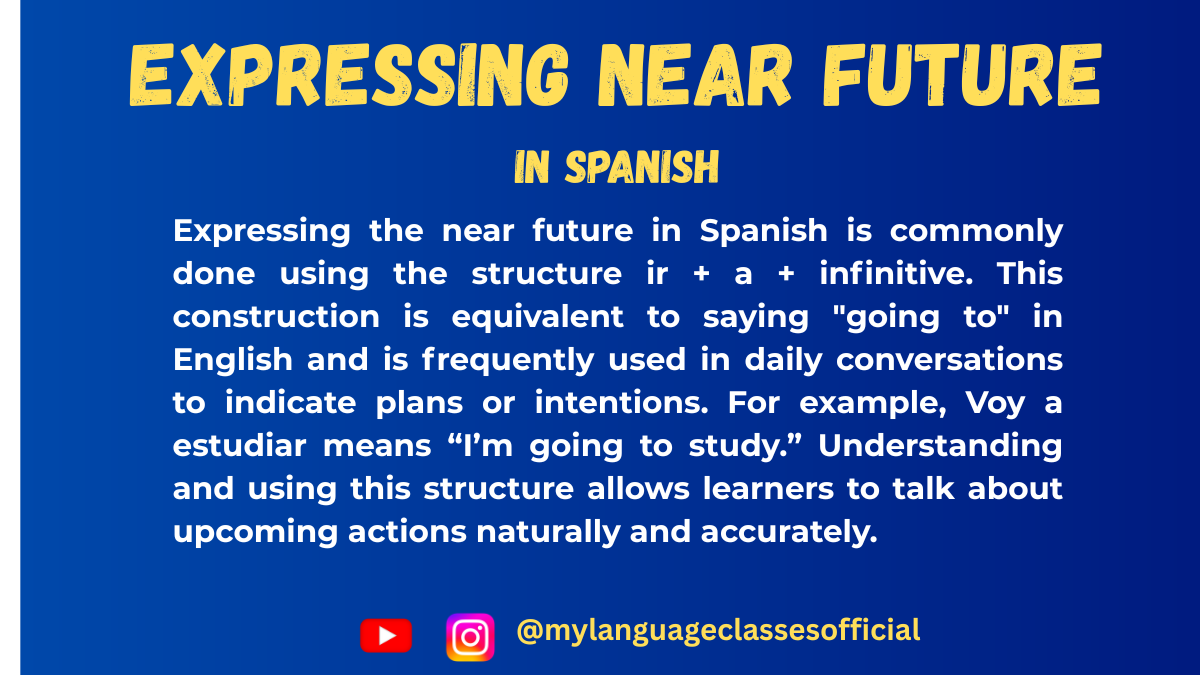
Ir a + Infinitive: Expressing Near Future in Spanish
In Spanish, the construction “Ir a + infinitive” is commonly used to express actions that will happen in the near future. This is equivalent to the English “going to + verb” structure. It is widely used in spoken and written Spanish and is easier to learn compared to the simple future tense.
Formation of “Ir a + Infinitive”
The structure consists of three elements:
- The verb “ir” (to go) conjugated in the present tense.
- The preposition “a” (to).
- An infinitive verb (unconjugated verb).
Conjugation of “Ir” in Present Tense:
Subject Pronoun Conjugation of “Ir” Yo voy Tú vas Él/Ella/Usted va Nosotros/as vamos Vosotros/as vais Ellos/Ellas/Ustedes van Sentence Structure:
Subject + Ir (conjugated) + a + Infinitive Verb
Example Sentences:
- Voy a estudiar. (I am going to study.)
- Vamos a viajar a México. (We are going to travel to Mexico.)
- Ellos van a comprar una casa. (They are going to buy a house.)
Usage of “Ir a + Infinitive”
1. Near Future Actions
Used to express something that is about to happen soon.
- Voy a llamar a mi madre. (I am going to call my mother.)
- Ella va a cocinar la cena. (She is going to cook dinner.)
2. Intentions or Plans
Used when someone has planned to do something.
- Vamos a ver una película esta noche. (We are going to watch a movie tonight.)
- Voy a aprender español este año. (I am going to learn Spanish this year.)
3. Predictions Based on Evidence
Used when there is evidence that something is about to happen.
- Va a llover. (It is going to rain.)
- El bebé va a llorar. (The baby is going to cry.)
4. Giving Commands or Warnings
Used to give warnings or strong suggestions.
- Vas a romper el vaso. (You are going to break the glass.)
- Van a llegar tarde si no se apuran. (You all are going to be late if you don’t hurry.)
Articles, Gender, and Plural Considerations
When using “Ir a + Infinitive,” remember:
- Definite Articles (el, la, los, las) and Indefinite Articles (un, una, unos, unas) should match the noun in gender and number.
- Example: Voy a comprar una bicicleta. (I am going to buy a bicycle.)
- Example: Vamos a visitar el museo. (We are going to visit the museum.)
- Verb agreement: The conjugation of “ir” changes based on the subject.
- The infinitive verb does not change regardless of the subject.
Common Verbs Used with “Ir a + Infinitive”
Here is a list of common verbs and their “Ir a + Infinitive” forms:
Infinitive Verb Meaning “Ir a + Infinitive” Example Comer To eat Voy a comer pizza. (I am going to eat pizza.) Beber To drink Vas a beber agua. (You are going to drink water.) Estudiar To study Ella va a estudiar matemáticas. (She is going to study mathematics.) Viajar To travel Vamos a viajar a España. (We are going to travel to Spain.) Comprar To buy Van a comprar un coche. (They are going to buy a car.) Hacer To do/make Voy a hacer mi tarea. (I am going to do my homework.) Tener To have Vas a tener una sorpresa. (You are going to have a surprise.) Llegar To arrive Ella va a llegar temprano. (She is going to arrive early.) Jugar To play Vamos a jugar fútbol. (We are going to play soccer.) Dormir To sleep Van a dormir temprano. (They are going to sleep early.) Regular and Irregular Verbs in “Ir a + Infinitive”
All verbs, whether regular or irregular, remain in the infinitive form after “a.”
Regular Verbs (AR, ER, IR Verbs)
- Hablar (to speak): Voy a hablar con mi amigo. (I am going to speak with my friend.)
- Comer (to eat): Vamos a comer paella. (We are going to eat paella.)
- Vivir (to live): Ellos van a vivir en Barcelona. (They are going to live in Barcelona.)
Irregular Verbs
- Hacer (to do/make): Voy a hacer la tarea. (I am going to do the homework.)
- Tener (to have): Ella va a tener una fiesta. (She is going to have a party.)
- Poder (to be able to): Van a poder salir temprano. (They are going to be able to leave early.)
Conclusion
The “Ir a + Infinitive” structure is one of the most practical and commonly used ways to express the near future in Spanish. It is simple to form and widely understood in all Spanish-speaking regions. By practicing this structure with different verbs, you can quickly improve your Spanish fluency and express future plans with confidence.
Now that you understand how to use “Ir a + Infinitive”, start practicing by forming your own sentences!
If you enjoyed this lesson, be sure to check out more posts like this on my blog at My Language Classes. Don’t forget to subscribe my YouTube channel and follow me on Instagram for the latest language learning tips and lessons. Leave a comment below to share your thoughts, or ask any questions you have.
Happy learning! 😊

